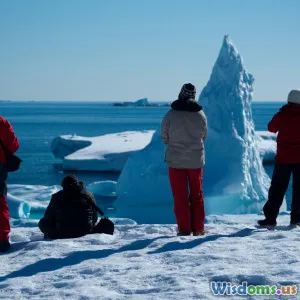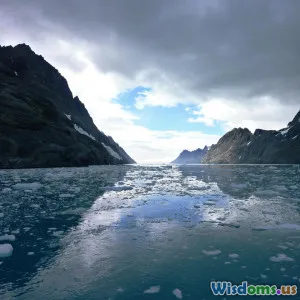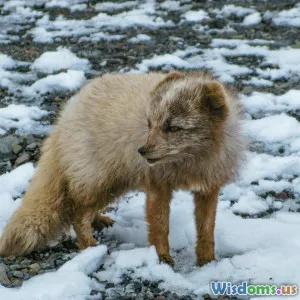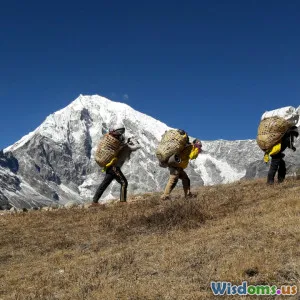
Inside the World of Scientists Each Winter at the South Pole
18 min read Explore the unique experiences and challenges faced by scientists living and working at the South Pole each winter. (0 Reviews)
Inside the World of Scientists Each Winter at the South Pole
Few places on Earth are as extreme or as captivating as the South Pole in winter—a frozen frontier where temperatures regularly plummet below -70°C, the sun doesn’t rise for months, and the nearest civilization is over a thousand kilometers away. Yet, each year, a dedicated team of scientists and support staff willingly embrace the isolation and brutal weather to pursue research that simply cannot be replicated anywhere else. What draws these professionals to arguably the harshest working environment on the planet? Let’s peer into the hidden world of the South Pole’s winter scientists, their discoveries, daily routines, challenges, and the vital global impact of their efforts.
The Allure of the Long Polar Night

While many would balk at spending up to nine months in almost total darkness, a tight-knit, international group of researchers chooses to do just that every year. Their base: the Amundsen–Scott South Pole Station, perched directly atop the geographic pole. Each winter, the population at the station dwindles to around 40–50 inhabitants, with no way in or out until the next spring. But for these scientists, the chance to witness phenomena accessible nowhere else on Earth often outweighs the discomforts.
The polar night—the period from late March to late September when the sun never rises—is a primary source of awe and scientific opportunity. The long, uninterrupted darkness turns the South Pole into one of the best places on Earth for astrophysical observations. It is during this period that instruments like the South Pole Telescope and the IceCube Neutrino Observatory gather their richest data, peering farther into the universe or delving beneath the ice to detect mysteries from distant cosmic events. Imagine gazing out at a sky alive with Aurora Australis—a riot of greens and purples pirouetting silently overhead—part of the majesty fueling the scientists’ resolve.
Remarkable Research Dreams (and Realities)

What compels researchers to venture to the bottom of the world? For many, the answer lies in the unique geography and climate, which enables science that is impossible elsewhere. The logistical and engineering feats behind projects like the IceCube Neutrino Observatory are staggering: over 5,000 basketball-sized sensors embedded in a cubic kilometer of Antarctic ice, all deployed to capture faint signals from high-energy particles that zip through space—and occasionally, the Earth.
Other teams monitor the Cosmic Microwave Background (using the South Pole Telescope), searching for hints about the earliest days of the Universe. The air at the pole is some of the planet’s clearest and driest, so microwaves and submillimeter waves suffer little interference. Experiments such as BICEP and SPUD take readings that inform our understanding of the cosmos, hoping to glimpse the fingerprints of inflation in the universe’s first seconds.
Meteorologists, glaciologists, and climate scientists undertake long-term studies here as well, measuring minute changes in the ice sheet, snow accumulation, and atmospheric chemistry. Their findings feed directly into global climate models, sharpening our view of how warming ocean currents and rising air temperatures translate to changes in the cryosphere—a critical data point as the world tracks climate change trajectories.
Day-to-Day Life: Routines for Resilience

Survival in the Antarctic winter requires discipline, creativity, and camaraderie. With the last plane departing in February and another not expected until late October, residents quickly adapt to a meticulously planned routine, blending research with chores and much-needed leisure.
Mornings start with hearty breakfasts, followed by safety briefings and distributed tasks: snow shoveling to keep entrances clear, equipment inspections, or troubleshooting station infrastructure. For scientists, much of the day is spent calibrating instruments, analyzing initial results, or dialing into conference calls with distant universities—sometimes balancing satellite communications against frequent outages due to weather.
Meals take on special importance, not only for nutrition but as the foundation for community-building. Professional chefs prepare menus from shelf-stable and frozen goods (the last fresh fruit disappears early in the season), and Friday or holiday meals are an event, with themed dinners or movie nights. Birthday celebrations take on heightened meaning, often marked with homemade cakes and imaginative decorations derived from limited supplies.
Recreation is key to morale: polar residents organize trivia nights, board game tournaments, yoga sessions, and even a traditional midwinter fête replicating the spirit of Christmas in June. The time spent nurturing these simple joys is an essential counterweight to the monotony and psychological toll of the test.
Navigating Technology and Communication Limits

One of the most underestimated challenges for Antarctic scientists is the relative isolation imposed by strict bandwidth limitations. The station connects to the outside world primarily via geosynchronous satellites that remain low on the horizon. Data from scientific instruments sometimes must be prioritized over personal correspondence. Video calls are rare and restricted; communication with family and friends happens mainly through email—a reminder of the bygone era before constant digital connectedness.
In emergencies, traditional techniques come into play. The station maintains shortwave radios, and many winter-overs learn basic amateur “ham” radio operation. These skills, once common for remote scientists, now serve both as a fail-safe and as a way to join a global community of amateur radio enthusiasts, connecting across continents despite circumstance.
Despite the heavy reliance on technology, ingenuity is often called for when equipment breaks down. Without spare parts or external help, engineers and mechanics—often cross-trained—must improvise repairs. There's an in-joke in polar stations: “If you don't have it, you invent it.”
The Mental Marathon: Coping With Isolation and Darkness

The psychological gauntlet of a South Pole winter surpasses the mere physical ordeal. Months without sunlight impact circadian rhythms and can trigger depression or seasonal affective disorder. The extreme cold means even short walks outside entail heavy gear and careful planning. Meanwhile, the knowledge that evacuation is impossible until spring reinforces the need for thorough preparation and robust mental health protocols.
Teams mitigate this by maintaining predictable schedules and emphasizing community—a lesson in group resilience. The “winter-over” cohort becomes an extended family, with designated times for communal recreation and mutual support. Psychological screenings prior to deployment help ensure that all members can adapt to the extraordinary stresses of isolation.
Personal rituals are treasured: many participants keep journals, immerse themselves in creative arts or photography, or create traditions such as tracking the exact date and hour of the return of the first sunrise. Over the decades, countless narratives, artworks, and even novels have originated from this forced retreat from civilization. The darkness provides fertile ground for reflection, inspiration, and a unique sense of accomplishment once the sun graces the horizon again.
Embracing Danger: Preparing for Medical and Practical Emergencies

Without the possibility of air evacuation for months, the South Pole Station must function as a self-sufficient outpost. Each winter crew includes at least one highly trained doctor or physician’s assistant, often with supplementary training in dentistry and minor surgeries. Their tiny clinic is equipped for routine care, minor procedures, and basic life support, but serious emergencies require resilience and ingenuity.
Perhaps the most famous example is Dr. Jerri Nielsen, who self-diagnosed her own breast cancer during winter 1999 and famously performed a biopsy and administered chemotherapeutic drugs—guided remotely by physicians thousands of miles away until she could be rescued after nine months. The incident sparked extensive changes in station medical kits and training for all winter-over crews.
Training in self-reliance is the norm: everyone undergoes safety and emergency response drills. Scenarios include plumbing failures, fires (a constant concern when open flames and electronics heat the interiors), or loss of critical systems. There’s even a small greenhouse, doubling as both a supplies source for fresh greens and a controlled training environment for working in confined conditions.
Uncovering Antarctica’s Past and Predicting the Planet’s Future

While astronomical experiments steal most headlines, the South Pole’s ice tells secrets of Earth’s distant past—and warnings about its future. Teams deploy advanced ice drills capable of extracting cores up to 3 kilometers below the surface. Each layer of trapped air bubbles and dust reveals atmospheric conditions from tens or even hundreds of thousands of years ago.
Analysis of these ice cores has dramatically extended our understanding of past glacial cycles, revealing patterns of climate change, ancient volcanic eruptions, and shifts in greenhouse gas concentrations. This data anchors the world’s present-day climate models. The unique positioning of the pole, far from industrial, urban pollution, ensures that samples are uncontaminated—offering a purer record than almost anywhere else.
Moreover, every winter, additional “snow pits” and automatic weather stations log data on snowfall, surface melting, and temperature anomalies. It is painstaking, repetitive work—sometimes requiring carefully digging by hand in blizzard conditions—but the insights generated are invaluable. For example, polar meteorology has direct links to forecasting worldwide weather patterns, understanding El Niño and La Niña dynamics, and tracking ozone hole recovery after decades of coordinated international action.
The Unique Camaraderie: Building a Community in Extremes

Polar researchers often say that the real wonder of overwintering isn’t just in the science—it’s in the people and bonds forged by shared adversity. Each station winter-over season is marked by orientation rituals (like the symbolic burning of “the last sunset” piano or celebratory group portraits at the exact South Pole), and rejuvenated by midwinter feasts echoing traditions of explorers like Scott and Amundsen—right down to hand-delivered “midwinter greetings” sent via email from every other Antarctic station.
There are unique traditions, such as the ceremonial “300 Club”: only after the temperature drops below -100°F (-73°C), would-be clubsmen can run from the station’s sauna (heated to +200°F or almost 93°C) into the open polar night, completing a quick, breath-defying dash around the station in only swimsuits and boots. It’s an act equal parts thrill-seeking, bravado, and outright camaraderie—making return to warmth all the sweeter amid raucous laughter.
Friendships that begin here often extend beyond the continent, and a shared sense of accomplishment forms the backbone of lifelong affiliations in science, adventure, and teamwork. The isolation, far from being depersonalizing, brings a sense of belonging that is rare anywhere else.
Global Impact: Why the South Pole Still Matters

It’s easy to view the South Pole as a remote, forbidding corner of Earth with little daily relevance. But nearly every facet of life at the Pole reverberates far beyond its latitude. Discoveries made here—about the nature of the universe, the historical trajectory of the planet’s climate, and microbial life adapting to extremes—continue to influence scientific policy and practice worldwide.
In an era of accelerating climate change, data gathered from long-term polar stations forms the backbone of international agreements and informs predictions about sea-level rise and extreme weather. In astrophysics, neutrino detections and microwave background observations impact everything from our understanding of star formation to theories of fundamental physics.
Equally important is the demonstration of international cooperation: the South Pole remains a model of scientific partnership, where researchers from across the globe share resources, collaborate freely, and seek answers larger than any single nation could muster alone. The Station’s ability to withstand the severest conditions while producing some of the world’s most valuable research stands as a testament not just to resilience, but to the indomitable curiosity propelling human progress.
So the next time you look up at the stars, contemplate a climate headline, or marvel at feats of endurance and ingenuity, remember the dedicated teams under the Antarctic night: their work, in darkness and isolation, is quietly shaping the future for the rest of the world.
Rate the Post
User Reviews
Popular Posts




















